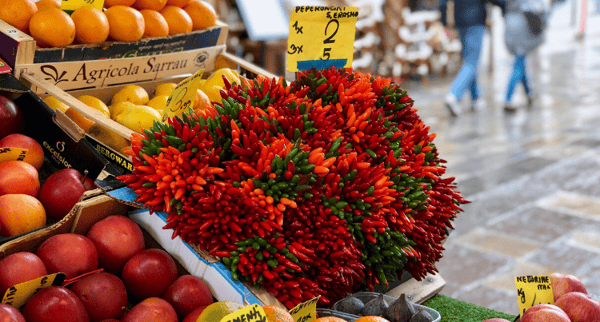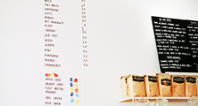Much of what we see and write about food cost tends to be a “global” food cost. But does this overlook a crucial aspect of costing? The cost of individual menu items can be just as important to examine, and there are a lot of seemingly minor contributing factors that can have a major impact on your establishment’s bottom line.
In today’s post, guest blogger Mike Walmsley walks us through the how and why of costing individual menu items.

When we say the phrase “global food cost”, we’re talking about the total food cost in your establishment at the end of the month when you consider all contributing factors. It’s an industry standard calculation – opening food inventory, plus purchases and minus closing inventory.
The resulting value, when compared to the month’s food sales, gives you a global food cost percentage – in other words, the relative cost of all food consumed in your establishment for a set period of time (generally month-by-month).
But what about individual food cost – the cost for each menu item you present before a customer? And why is this important?
In short, it’s going from the macro (the whole month) to the micro (each menu item).
Each food item on your menu has a different food cost
There are several factors that contribute to this; for example, an individual menu item may have high-cost ingredients in the recipe, or it takes a high amount of labor and skill to prepare.
This item would have a different food cost to a simple menu item with inexpensive ingredients that requires a low amount of labor and skill to prepare (compare, for example, French fries to Beef Wellington).
This is where we can get into individual food cost, and the nuances of the overall financial contribution of each menu item.
Learn more about food cost from industry experts in online short courses at typsy.com
Calculating food cost percentage
In very general terms, that are three things that influence the food cost for individual menu items:
- The size of the portion
- The cost of the raw ingredients (both the recipe and the raw input costs)
- The sale price
The relationship between these numbers gives the cost of sales (COS), or food cost percentage. This is simply the ratio of cost of raw ingredients to the on-menu price: cost per portion of raw ingredients, divided by sale price.
For example: if we look at a single serving of French fries, the portion size may be 6 ounces (170g) of finished product; the cost per portion of raw ingredients may be $0.75; and the selling price might be $2.75. With those figures, the food cost for this item would be $0.75 / $2.75, for an individual food cost percentage of 27%.
But how can we tell if this percentage ratio is optimal, or even appropriate? It depends on a few factors.
The type of enterprise is one thing to consider. A full-service restaurant may have to add the cost of plate presentation. For example, fries may be served on a standard plate with a garnish.
For a QSR where French fries are a takeout item, we would have to add the cost of the wrapper and perhaps a couple of packets of ketchup, thus increasing the overall cost of that particular menu item. When we add the takeaway wrapper, the packets of ketchup, and maybe a salt portion, the “raw” cost changes from $0.75 to $0.97, a jump from an individual food cost percentage of 27% to 35%.
Sure, but is it really that important?
There are six main reasons why we need to think about the food cost percentage:
- After the extra items – condiments, packaging, and so on – are take into consideration, one portion for French fries actually contributes $0.22 less than initially calculated. This represents a decrease of over 10%!
- It can help you calculate the potential food cost by analyzing the number of portions sold
- You can set and check standard recipes and portion sizes for consistency
- It will enable you to adjust the selling price as and when needed (for example, if the raw cost of an ingredient increases)
- Any increases or decrease in the cost of the portion size will change the COS
- It can help you evaluate and adjust portion size, depending on the calculated individual food cost for that menu item
Similarly, “convenience” or pre-portioned foods can have a significant impact on individual, as well as global, food cost.
Consider this scenario in your establishment: if you purchase meat in bulk, and do your own in-house butcher work, your food cost might be 37% and your labor 41%. However, this means you gain the ability to maximize all the “left overs”: you can make your own hamburger, your own stocks, and other components of your menu items, potentially saving you costs within other menu items.
If, on the other hand, you purchase pre-portioned meat and eliminate your in-house butcher, your food cost could increase to 45% and your labor might decrease to 25%, but you also lose the opportunity to make use of offcuts for other menu items, thereby potentially increasing the food cost for other items in the process.
In this way, these kinds of decisions can significantly impact your global food cost.
How do these calculations affect your establishment's business model?
Weighing these options is a management decision; it’s part of how you choose to operate your business, and the effects in the above example are obvious. This is one reason why it’s hard to nail down an industry standard for food cost and labor cost – a lot depends on the operational decisions you make for your business.
Each option has pros and cons, and several considerations come into play to come up with the “right” choice. What's right for one establishment may not be right for another.
And what does this have to do with individual food cost?
In some ways the second scenario – the pre-portioned meat – is a little easier to manage from a cost perspective. If you are buying pre-portioned steaks with very exacting purchasing specifications you can zoom in to the exact quality, fat content, age and size every time.
That’s part of the benefit of this option, and it’s what you’re paying extra for. Along with assured quality and consistency, you would know what the exact price is per portion of steak.
It may also be easier to contract this with a supplier, safeguarding constant quality and consistent price over time. This goes a long way to controlling portion size, price per potion and, in the end, individual food cost.
It also reduces the cost of labor, material waste, training and qualifications of having an in-house butcher, or a part timer that hopefully gets the portioning right, 50% of the time.
Ultimately, there is no one-size-fits-all solution to how to prioritize the different aspects that influence individual food cost. The important thing is to remain aware of the micro, and how it will impact the macro.
 |
Mike Walmsley is the author of '69 Tips For Better Food & Beverage Profit'. Stay tuned for the next book in the series, '101 More Tips For Better Food & Beverage Profit', coming out soon on Amazon! |
Have a question about food cost management courses? We’re always ready to talk.
.gif?width=1200&height=400&name=Hubspot%20Blog%20banner%20GIF%20(2).gif)
.png?width=600&name=Typsy%20%20We%20teach%20hospitality%20to%20the%20world%20%20typsy.com%20blog%20banner%20_%20(1).png)





